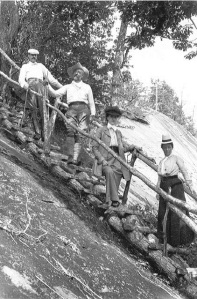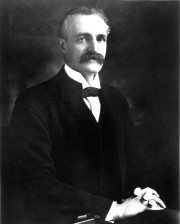On October 17, 1916, the Pisgah National Forest was the first national forest established under the Weeks Act of 1911. Written by FHS historian Jamie Lewis, this post was originally published in the online version of the Asheville Citizen-Times on October 14, 2016, and in print on October 16 to mark the centennial.
“When people walk around this forest … at every step of the way, they’re encountering nature, some of which has been regenerated by the initiatives of those generations they know not—they know nothing about. And I think that that’s ultimately the greatest gift: that you’ve given to them beautiful, working landscapes and you don’t know where they came from.”
Historian Char Miller closes our new documentary film, America’s First Forest, by acknowledging those who labored to create the Pisgah National Forest, which celebrates its centennial on October 17. We chose that quote because it simultaneously summed up the Pisgah’s history and looked to its future by implicitly asking who would carry on the work of the early generations in managing this national forest.
Miller is right. The Pisgah is a gift from many people—some whose names are familiar but many whose names are not. Most have heard of George Vanderbilt, or his Biltmore Estate. His greatest gift, however, was not to himself but to the nation. He hired renowned landscape architect Frederick Law Olmsted to design Biltmore’s grounds. Creator of New York’s Central Park and other urban green spaces, Olmsted saw in this project opportunity to give back to the nation, and through Vanderbilt a way to do so. In 1890, Vanderbilt needed a forester. America needed forestry. Olmsted advised hiring a professional forester who would demonstrate to America that one could cut trees and preserve the forest at the same time.
Vanderbilt hired Gifford Pinchot, who then crafted the first-ever sustainable forest management plan in the United States. Pinchot later gave back to the country in his own way: in 1905, he established the U.S. Forest Service, providing the nation with an institution to manage its national forests and grasslands. But before leaving Vanderbilt’s employ in 1895, Pinchot did two things: he facilitated Vanderbilt’s purchase of an additional 100,000 acres, which Vanderbilt named Pisgah Forest, and he recommended hiring German forester Carl Schenck to implement his management plan.
Schenck’s “experimental” practices not only restored the forest but also improved its wildlife and fish habitat. This turned Pisgah Forest into a revenue source as well as a playground for its owner: a sustainably managed forest can provide all those things and more.
In 1898 Schenck established the Biltmore Forest School—the country’s first forestry school—to educate men wanting to become forest managers or owners. Many of the nearly 400 graduates also served in the Forest Service. The impact of Schenck’s gift is still seen on public and private forests today. Thankfully Congress preserved the school grounds as the Cradle of Forestry in America historic site.

On top, George W. Vanderbilt; next to him, his friend and physician, Dr. S. W. Battle; next, Mrs. Edith Vanderbilt in her riding suit; lowest, Miss Marion Olmsted, daughter of the famous landscape architect Frederick Law Olmsted, Sr. Photo taken in 1901 at Lookingglass Rock. (FHS356)
These men are not the only ones to thank for the Pisgah National Forest. In 1899 Asheville physician Chase Ambler mobilized citizens to protect the region’s scenery and climate. Pressured by conservation groups from the South and New England, Congress passed the Weeks Act of 1911, which empowered the federal government to purchase private land for the Forest Service to manage. This legislative gift pleased not only preservationists like Ambler by protecting scenery and recreation areas, but also conservationists because the land remained available for logging and other extractive activities.
In 1914 George Vanderbilt’s widow, Edith, sold Pisgah Forest for a fraction of its value in part to “perpetuate” the conservation legacy of her husband, and as a “contribution” to the American people. Pisgah Forest became the nucleus of the Pisgah National Forest, the first established under the Weeks Act, and Biltmore Forest School graduate Verne Rhoades became its first supervisor, in 1916.
But that is the past. The future of the Pisgah National Forest (and its neighbor the Nantahala) is being written now. The U.S. Forest Service is drafting a forest management plan to guide how it manages the forests for the next dozen or so years. At public meetings, the Forest Service has been hearing from citizens and groups like the Pisgah Conservancy to help it craft the forest’s future. Like Carl Schenck and Vern Rhoades before them, Pisgah’s current managers face great uncertainties, only now in the form of forest pests and disease, climate change, and a place so attractive that its visitors are “loving it to death.” Those who cherish the Pisgah for its “beautiful, working landscapes” can honor those who gave us that gift by continuing to sustainably manage it. That can ultimately be our greatest gift to future generations.

Normally the entrance to a national forest has a small sign with the Forest Service shield on it. This entrance to the Pisgah National Forest was a memorial arch constructed to honor the memory of the men of Transylvania County, North Carolina, killed in World War I. (U.S. Forest Service photo — negative number 185843)






























